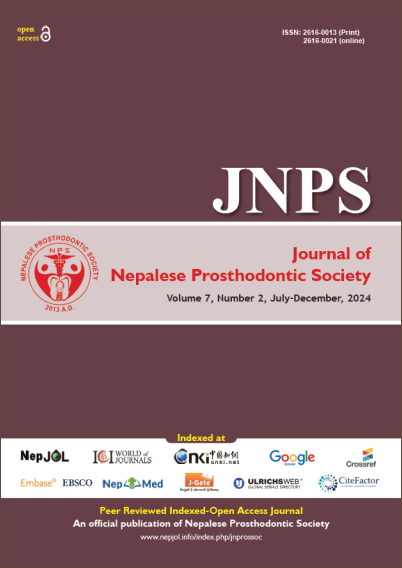Assessment of Need of Prosthodontic Rehabilitation of Endodontically Treated Teeth in Patients Attending a Tertiary Care Center in Nepal
DOI:
https://doi.org/10.3126/jnprossoc.v7i2.77557Keywords:
Crown, Endodontic Treatment, Pericervical Dentine (PCD), Post and Core, Post Endodontic Restoration, Remaining Dentinal Thickness, Root CanalAbstract
Introduction: Endodontically treated teeth (ETT) are structurally weaker than vital teeth. Therefore, post endodontic restorations are needed to enhance structural integrity, to restore from, function and aesthetics, to prevent bacterial microleakage, to ensure periodontal health and to protect residual tooth structure from fracture, wear or abrasion. The type of post endodontic restoration chosen depends greatly on the amount of remaining tooth structure. The best current approach for restoring the root treated teeth (RTT) should be minimal tissue sacrifice, protection of remaining dentin especially the peri cervical dentine (PCD) and choice of best post endodontic restoration according to the amount of tooth structure loss.
Objectives: This study aimed to assess and determine the need and type of different types of prosthodontic rehabilitation or restoration of different endodontically treated teeth in patients attending TUTH, Nepal. We also aimed to investigate the need of different treatment options on the basis of remaining dentinal thickness (RDT) to recommend the various types of post endodontic restoration to the patients.
Materials and Methods: 360 patients (n =360) that underwent root canal treatment (RCT) in the Department of Dental Clinical Sciences I (Conservative Dentistry and Endodontics) were evaluated for RDT, Possibility of Chamber Retention, number of remaining walls and number of roots. Radiovisograph (RVGs), clinical pictures and impression were taken and casts were fabricated to determine the RDT, PCD, occlusion, tooth type and the type of force exerted on it. A group of 5 experts (2 endodontists and 3 prosthodontists) evaluated the case and the rehabilitation options were recommended.
Results: Out of 360 patients, 51.3% were male and 49.7% were female. The most frequently treated tooth was three rooted molars (35.8%) followed by two rooted molars (34.7%) followed by mandibular premolars (8.6%).8.3% of the patient were found to have compromised PCD. The condition of chamber retetion of the majority of the teeth ( 90.6%) that were treated and included in this study was adequate .Composite and reinforeced compsoite resin restoration were planned in 5.8% and 9.7% of the cases. Veneers, endocrwons, inlay and onlay were indicated in 2.8%, 3.9%, 8.9% and 21.9% of cases respectively. Similarly, Fiber post core crown, cast post core crown and full coverage crown were indicated in 2.8%, 7.2% and 36.9% respectively.
Conclusions: This study focus on the preservation of maximum amount of tooth structure and evaluation of remaining tooth structure for deciding post endodontic restoration and recommendation has been formulated on the basis of same.
Downloads
Downloads
Published
How to Cite
Issue
Section
License
Copyright (c) 2024 The Author(s)

This work is licensed under a Creative Commons Attribution-NonCommercial-NoDerivatives 4.0 International License.
This license enables reusers to distribute, remix, adapt, and build upon the material in any medium or format, so long as attribution is given to the creator. © The authors




